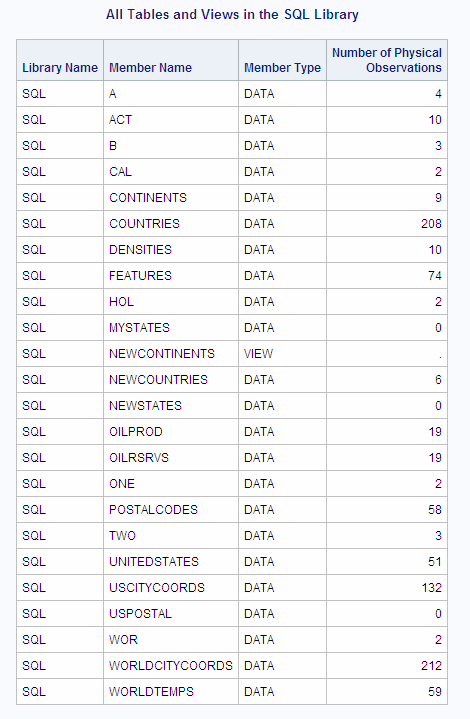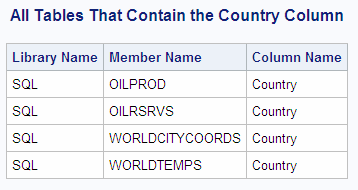Accessing SAS System Information by Using DICTIONARY Tables
What Are Dictionary Tables?
DICTIONARY tables are special read-only PROC SQL tables
or views. They retrieve information about all the SAS libraries, SAS
data sets, SAS system options, and external files that are associated
with the current SAS session. For example, the DICTIONARY.COLUMNS
table contains information such as name, type, length, and format,
about all columns in all tables that are known to the current SAS
session.
PROC SQL automatically
assigns the DICTIONARY libref. To get information from DICTIONARY
tables, specify DICTIONARY.table-name in the FROM clause in a SELECT
statement in PROC SQL.
DICTIONARY.table-name
is valid in PROC SQL only. However, SAS provides PROC SQL views, based
on the DICTIONARY tables, that can be used in other SAS procedures
and in the DATA step. These views are stored in the SASHELP library
and are commonly called “SASHELP views.”
For an example of a
DICTIONARY table, see Reporting from DICTIONARY Tables.
The following table
describes the DICTIONARY tables that are available and shows the associated
SASHELP views for each table.
Retrieving Information about DICTIONARY Tables and SASHELP Views
To see how each DICTIONARY table is defined, submit
a DESCRIBE TABLE statement. This example shows the definition of DICTIONARY.TABLES:
Definition of DICTIONARY.TABLES
NOTE: SQL table DICTIONARY.TABLES was created like: create table DICTIONARY.TABLES ( libname char(8) label='Library Name', memname char(32) label='Member Name', memtype char(8) label='Member Type', dbms_memtype char(32) label='DBMS Member Type', memlabel char(256) label='Data Set Label', typemem char(8) label='Data Set Type', crdate num format=DATETIME informat=DATETIME label='Date Created', modate num format=DATETIME informat=DATETIME label='Date Modified', nobs num label='Number of Physical Observations', obslen num label='Observation Length', nvar num label='Number of Variables', protect char(3) label='Type of Password Protection', compress char(8) label='Compression Routine', encrypt char(8) label='Encryption', npage num label='Number of Pages', filesize num label='Size of File', pcompress num label='Percent Compression', reuse char(3) label='Reuse Space', bufsize num label='Bufsize', delobs num label='Number of Deleted Observations', nlobs num label='Number of Logical Observations', maxvar num label='Longest variable name', maxlabel num label='Longest label', maxgen num label='Maximum number of generations', gen num label='Generation number', attr char(3) label='Data Set Attributes', indxtype char(9) label='Type of Indexes', datarep char(32) label='Data Representation', sortname char(8) label='Name of Collating Sequence', sorttype char(4) label='Sorting Type', sortchar char(8) label='Charset Sorted By', reqvector char(24) format=$HEX48 informat=$HEX48 label='Requirements Vector', datarepname char(170) label='Data Representation Name', encoding char(256) label='Data Encoding', audit char(8) label='Audit Trail Active?', audit_before char(8) label='Audit Before Image?', audit_admin char(8) label='Audit Admin Image?', audit_error char(8) label='Audit Error Image?', audit_data char(8) label='Audit Data Image?', num_character num label='Number of Character Variables', num_numeric num label='Number of Numeric Variables' );
Using DICTIONARY.TABLES
DICTIONARY tables are commonly used to monitor and manage
SAS sessions because the data is more easily manipulated than the
output from other sources such as PROC DATASETS. You can query DICTIONARY
tables the same way you query any other table, including subsetting
with a WHERE clause, ordering the results, and creating PROC SQL views.
Note that many character
values in the DICTIONARY tables are stored as all-uppercase characters;
you should design your queries accordingly.
Because DICTIONARY tables
are read-only objects, you cannot insert rows or columns, alter column
attributes, or add integrity constraints to them.
Note: For DICTIONARY.TABLES and
SASHELP.VTABLE, if a table is read-protected with a password, then
the only information that is listed for that table is the library
name, member name, member type, and type of password protection. All
other information is set to missing.
Note: An error occurs if DICTIONARY.TABLES
is used to retrieve information about an SQL view that exists in one
library but has an input table from a second library that has not
been assigned.
The following query
uses a SELECT and subsetting WHERE clause to retrieve information
about permanent tables and views that appear in the SQL library:
libname sql '\\sashq\root\pub\pubdoc\doc\901\authoring\sqlproc\miscsrc\sasfiles\'; options nodate nonumber linesize=80 pagesize=60;
Using DICTIONARY.COLUMNS
DICTIONARY tables are useful when you want to find specific columns
to include in reports. The following query shows which of the tables
that are used in this document contain the Country column:
DICTIONARY Tables and Performance
When querying a DICTIONARY table, SAS
launches a discovery process that gathers information that is pertinent
to that table. Depending on the DICTIONARY table that is being queried,
this discovery process can search libraries, open tables, and execute
views. Unlike other SAS procedures and the DATA step, PROC SQL can
mitigate this process by optimizing the query before the discovery
process is launched. Therefore, although it is possible to access
DICTIONARY table information with SAS procedures or the DATA step
by using the SASHELP views, it is often more efficient to use PROC
SQL instead.
For example, the following
programs produce the same result, but the PROC SQL step runs much
faster because the WHERE clause is processed before the tables that
are referenced by the SASHELP.VCOLUMN view are opened:
data mytable; set sashelp.vcolumn; where libname='WORK' and memname='SALES'; run;
proc sql;
create table mytable as
select * from sashelp.vcolumn
where libname='WORK' and memname='SALES';
quit; Note: SAS does not maintain DICTIONARY
table information between queries. Each query of a DICTIONARY table
launches a new discovery process.
If you are querying
the same DICTIONARY table several times in a row, then you can get
even faster performance by creating a temporary SAS data set (with
the DATA step SET statement or the PROC SQL CREATE TABLE AS statement)
with the information that you want and running your query against
that data set.
When you query DICTIONARY.TABLES
or SASHELP.VTABLE, all the tables and views in all the libraries that
are assigned to the SAS session are opened to retrieve the requested
information.
You can use a WHERE
clause to help restrict which libraries are searched. However, the
WHERE clause will not process most function calls such as UPCASE.
For example, if
where UPCASE (libname) ='WORK' is used, the UPCASE function
prevents the WHERE clause from optimizing this condition. All libraries
that are assigned to the SAS session are searched. Searching all the
libraries could cause an unexpected increase in search time, depending
on the number of libraries that are assigned to the SAS session.
All librefs and SAS
table names are stored in uppercase. If you supply values for LIBNAME
and MEMNAME values in uppercase, and you remove the UPCASE function,
the WHERE clause will be optimized and performance will be improved.
In the previous example, the code would be changed to
where libname='WORK'.
Note: If you query table information
from a library that is assigned to an external database, and you use
the LIBNAME statement PRESERVE_TAB_NAMES=YES option or the PRESERVE_COL_NAMES=YES
option, and you provide the table or column name as it appears in
the database, you do not need to use the UPCASE function.
Copyright © SAS Institute Inc. All rights reserved.

